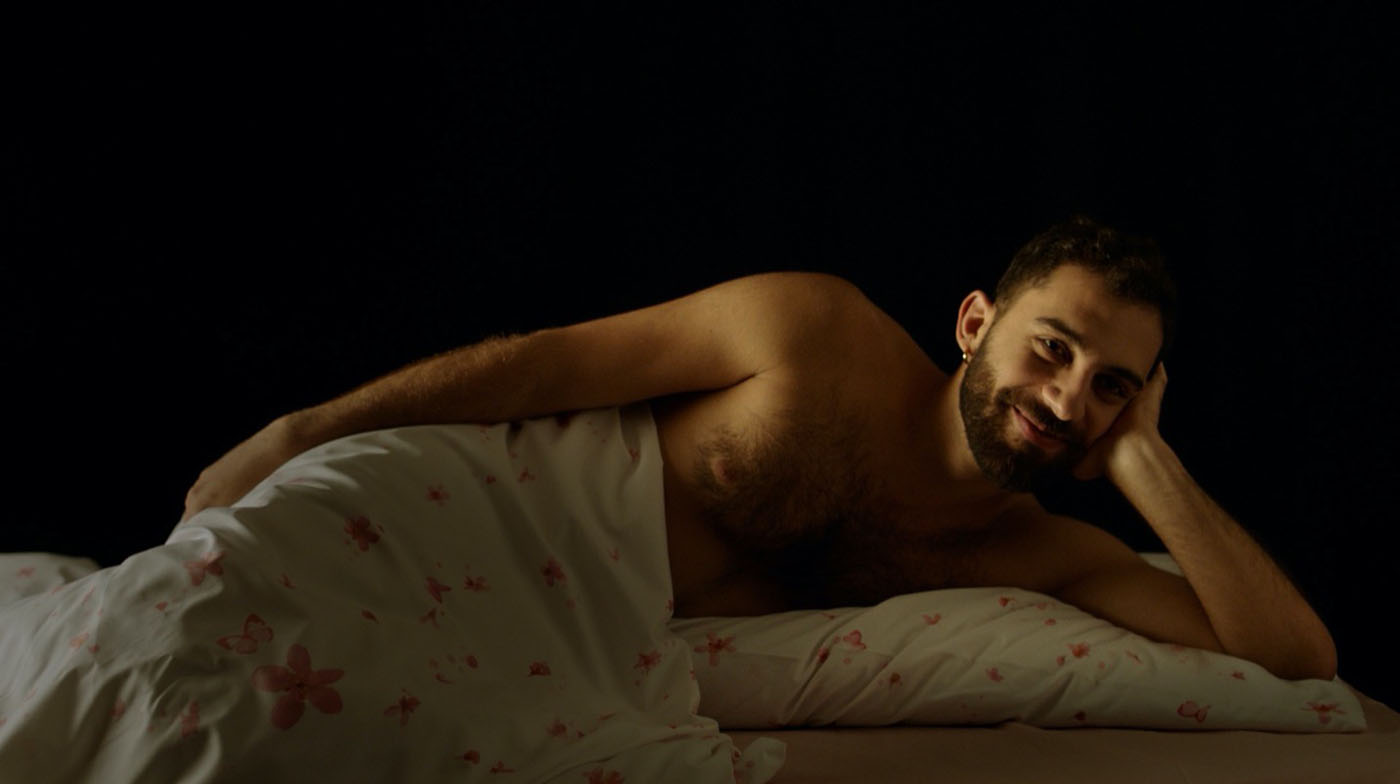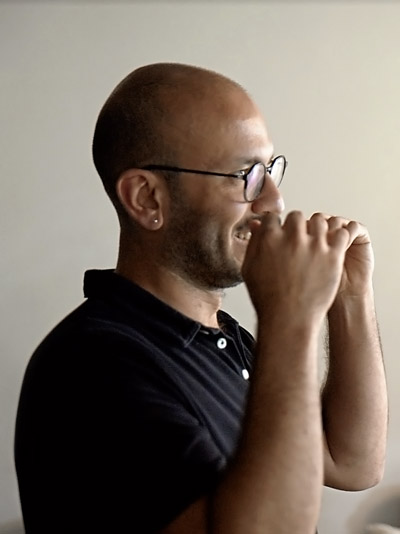
Queer possibilities for the impasse of narrative in Shall I Compare You to a Summer’s Day?
Iskandar Abdalla
From the very first moment, Mohammad Shawky Hassan’s film Bashtaalak Sa’at or Shall I Compare you to A Summer’s Day? (which had its premiere in the Forum section at the 2022 Berlinale Festival), seems to fall into conflict with its own possibilities of narration. How many stories can we tell about love? And if there is only one story to tell, how many versions can it have? And who shall tell which part? Shawky Hassan invokes Scheherazade (played here by Donia Massod), the mythical narrator and the greatest among all storytellers in One Thousand and One Nights, to weave a story or rather several stories of love that seem to elude the very act of “proper” telling. But Scheherazade’s exquisite art of telling lies apparently here not in coming up with a storyline that would sort out the quandary of narration and enthrall the listeners/viewers with the audacity of its perfection; it lies rather in questioning narratives; in entangling the tools and trajectories of their formation; in troubling their temporal dependencies and spatial framings.
Scheherazade’s storyline will soon be doubled and tripled. It frees itself from the alluring grip of its renowned teller to wander among the respective voices of all those who lived out the story(ies). The story becomes thus multivocal, multifaceted, embellished with intricately curved lines; an assemblage of memories and sensations of love that shift its owners — all nameless protagonists — that exchange positions, move between places, times, and bodies.
“I am struggling to understand where each story begins and ends… Do they even end? Or do new stories begin without us returning to the first one?” asks a nameless protagonist (Selim Mourad) his invisible counterpart, while lying naked under a flowery blanket and facing us — the viewers.
We are then not alone in facing this puzzling conundrum. The protagonists themselves seem to get lost in the maze of a plot that weaves its stories around and through their bodies, that ties them together in times and sets them apart in other times, that seems to be ruled by a unique order of incidents. The incidents themselves can be recalled, nevertheless one can never be sure who told what first and why one keeps on telling the same stories one already knows. Is that what we can call a queer narrative?
Berlin is a queer haven, or that is how the city at least hopes to appear. No bars seem to block the horizons of expression when queer artists are at stake. Nevertheless, when you are both queer and Arab, having a place and a voice in such a haven is subject to a set of conditions and pre-established perceptions. The point here is not that the stories of queer Arabs are ignored or remain underrepresented, but that their representation must often correspond to certain modes of framing and templates of narration. In the West, queer Arabs are hailed when they speak as victims of a patriarchal culture they left behind, or when they express their gratitude for a gay-friendly present they are supposed to embrace. But can queer Arabs speak about love beyond culturalist framings and narratives of victimhood?
Many of the protagonists of Shall I Compare you to A Summer’s Day? and the director himself live in Berlin. But the film is eventually a film about love. And for it to be only about love the film forgoes taking place in any specific time or region. Nevertheless, its rootedness in local Arab-Egyptian culture is unmistakably conspicuous. Egyptian popular songs and film dialogues function in the film not only as references for the unfolding stories of love and lust, they rather endow the film’s narrative with its very possibility to come forth and materialize a multitude of discourses about love and desire. Ramadan’s musical riddle shows, known as Fawazeer, and Egyptian televised Tales of Thousand and One Nights are evoked and aesthetically reclaimed as a stage for picturing realms of queer love. Both shows had enjoyed remarkable popularity in the Arab-speaking countries during the ‘80s and early ‘90s. They shaped the horizons of imagination of a whole generation of viewers and conjured their affection with a unique world of phantasmal images, spectacular dance sketches, and theatrical sceneries that featured demons, witches, wizards, legendary kings, and queens.

In evoking such iconic images, Shawky Hasan pays tribute to an informal queer history of viewing; of fascination with the visual language and poetics of these shows; of their appropriation into intimate frames of identification that plead for freer possibilities of being, and shook free from the firm grip of gendered norms. In place of narrative templates that foreground a repressed sexuality confined to secrecy and inflicted by fear; in place of the familiar three act dramas of persecution, then flight, before finding liberation in a western queer haven like Berlin, queer Arab history of imagination is recast in the film as a vehicle of self-fashioning; of counterbalancing the sense of social alienation and patching up social boundaries. Queer Arab imagination becomes a sort of counter-imagination, entitled to frame one’s own affections, intimacies, ways of being, and desiring by drawing on a personal archive of visual memories and the affective registers they activate to envision being beyond racialized imageries and gendered dichotomies.
What is at stake is a queer utopia to be realized by the power of imagining freer domains for articulating love and desire. Its queer quality lies precisely in its denunciation to the notion of perfection. The kind of queer utopia featured in the film is inflicted by pain, grief, separation and even death. They become constituent to the experience of being queerly in love. It is a utopia that withstands the uprightness of affection, the straightness of bodies, desires but also of narratives.
Shawky Hassan’s film invites us to go beyond thinking about queer cinema in terms of the sheer representation of queer characters and stories, and to reckon rather with styles of expression and forms of storytelling that can be identified as queer. In other words, queer cinema should urge for forms and styles of creating meaning that better translate the intricacies of the queer experience; that correspond to the innovative ways by which queer people appropriate identities, practices and subvert heterosexual formats of being. In this logic, linear plotting and plain narration that capitalizes on a concatenation of single actions and clear-cut characters prove futile for representing queer love. In resorting to the spectacular character of popular songs and musical shows like Ramadan riddles, Shawky Hassan is relocating Arab queer experience in relation to an affectively structured archive of audiovisual memories and diverse modes of engagement with popular culture. On a different note however, restoring to the spectacular as a language of storytelling in general can be read as an expression of a sort of indifference if not of inimicality towards linear narrative progress, as Valerie Rohy[1] (2018) reminds us in her reading of Tony Scott’s film The Hunger (1983). This implies the rethinking of our established conventions about spectacle since Aristotle as a genre placed at the bottom of art, if not “the most of foreign to art” (Heller [2]1982, 240). But more importantly, the way how the film’s language appropriates spectacular components urges us to break with the opposition between narratives as the proper way of telling stories and spectacles as a crude mode of enthralling sentiments, characterized by diffusion and formal effects disposed of meaning. Such opposition reinforces namely heterosexual modes of straightening affective experiences and intimate encounters. Resorting to the spectacular entails furthermore the potential to queer narratives when doing so alludes to the failings of narratives; to their inevitable inadequacy for capturing the myriad manifestations and expressions of being in love; to their status as nothing but a “fantasy” that gives “formal and temporal coherence to an essential impasse of signification” (Rohy 2018, 153).
The English title of the film is borrowed from Shakespeare’s most famous sonnet in which the beauty of an unnamed young man is celebrated by the devoted poet. The first line of the sonnet brings this sort of inadequacy or impasse in the form of a question to the fore: Shall I compare thee to summer’s day?
Shakespeare’s question is rhetorical. Neither his beloved, nor his readers are expected to answer. From the outset, the comparison is doomed to fail as the next lines of the poem demonstrate. The beloved is more lovely and more temperate than a perfect summer’s day. Time passes and even the most immaculate English summer must be followed by fall. An analogy to what objectively seems to be the order of nature fails then to describe the experience of love. Queer love dodges description, not because it longs for perfection but because its horizons of imagination are out of joint; they neither can be confined by bounds of time, nor of space or the order of nature. Art too is not about longing for perfection but enacting eternity. And only by the virtue of a poetic imagination can love become eternal:
“But thy eternal summer shall not fade,
Nor lose possession of that fair thou ow’st;
Nor shall death brag thou wander’st in his shade,
When in eternal lines to time thou grow’st”
[1] Rohy, Valerie “The Cinema of the Impossible: Queer Theory and Narrative” in Zara Dinnen and Robyn Warhol (ed.) The Edinburgh Companion to Contemporary Narrative Theories (Edinburg University Press, 2018), 147-157.
[2] Heller, Janet Ruth, “The bias against spectacle in tragedy: the history of idea,” in The Eighteenth Century, Autumn 1982, Vol. 23. No. 3 (Autumn 1982), pp. 239-255.



